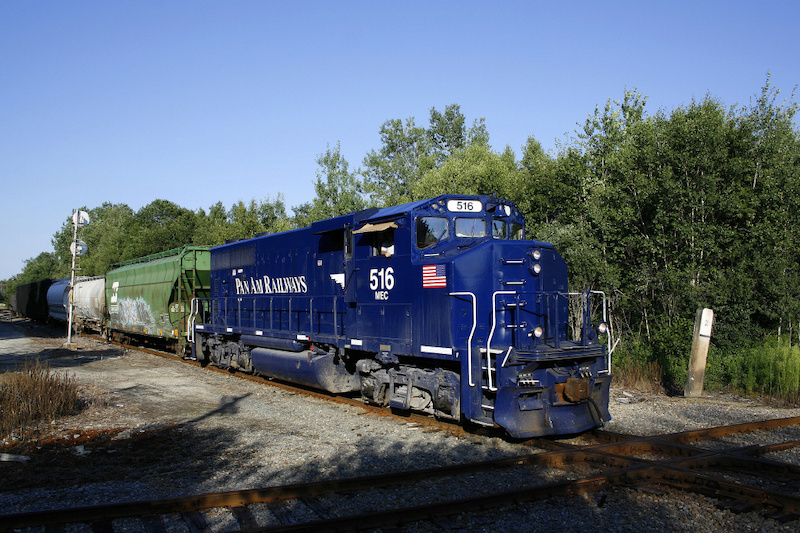By Justin Franz
WASHINGTON — Without significant investment, the core of the New England rail network will fall into an irreversible decline. That was the message pushed forward by CSX Transportation executives on January 13 and 14, during a U.S. Surface Transportation Board hearing about the Class I’s plan to acquire Pan Am Railways.
During two days of testimony, the federal regulator that will ultimately decide if the takeover will happen and what it could look like heard arguments from proponents and skeptics alike. Many of those who testified spoke in favor of the acquisition, citing Pan Am’s failure over the last 30 years to maintain its network. A big chunk of CSX’s presentation featured images of just how bad Pan Am’s track is in some places, and a promise to make it better, to the benefit of safety and shippers.
“If someone doesn’t put money into this railroad now, I’m not sure there will be much of a railroad left in the future,” said Jamie Boychuk, executive vice president of operations for CSX.
CSX said it plans to spend more than $100 million upgrading Pan Am’s track, particularly the old Maine Central, much of which is saddled with permanent slow orders. For CSX, that eastern gateway is the big prize of the Pan Am deal, because it would allow the Class I to interchange with New Brunswick Southern at Mattawamkeag, Maine, and thus have access to eastern Canada to compete with Canadian Pacific and Canadian National. CSX also said it could help build the business by offering more reliable service. CSX has estimated that traffic would increase by 2.3 percent annually for the first three years and 1.5 percent annually for the two years after that.
But those numbers didn’t click with some STB members, specifically Chair Martin J. Oberman, who wondered aloud if such a massive financial investment — $100 million in upgrades plus whatever CSX is paying Pan Am owner Timothy Mellon — was worth traffic gains of just one to three percent annually. CSX officials shot back and said that Pan Am would be “a 100-year asset” for the company. STB members seemed unconvinced.
Another sticking point for the STB was what would become of the former Boston & Maine across Massachusetts. As part of the transaction, Pan Am Southern — a joint venture between Pan Am and Norfolk Southern west of Ayer, Mass. — would be operated by Genesee & Wyoming as its Berkshire & Eastern. Some, including the Department of Justice, has called that an “imperfect” solution and that it would spur competitive issues, because G&W already dominates that part of New England and because CSX would directly or indirectly control the two main lines across western Massachusetts. But for the STB another issue arose: maintenance. Board members expressed an interest in putting in a requirement that someone — CSX, G&W or NS — maintain the former B&M at its current condition or better. But all parties involved were hesitant of such a requirement, especially because of the 147-year-old Hoosac Tunnel, which has been prone to cave-ins in recent years. Canadian Pacific also expressed concern about the future of the former B&M and its viability as a gateway into New England. The Canadian road asked that the STB to require that CSX and G&W to keep the CP-Pan Am interchange at Mechanicville, N.Y. open.
In the days before the hearing, CSX was able to line up support from Vermont Rail System, which had been a previous opponent. CSX and G&W have stated that they would give VRS trackage rights from White River Jct., Vt., south to East Deerfield, Mass., to ensure their own traffic is moved. The night before the hearing started, Amtrak also signaled its openness to the deal, although it was short of an enthusiastic endorsement. CSX announced that it would submit itself to some of the passenger railroad’s previous requests. The most notable one was that CSX would allow a trial run for a weekend passenger train called the Berkshire Flyer, between New York City and Pittsfield, Mass.
At the end of the hearing, viewers were left with the impression that regardless of what happens in the coming months, Pan Am — and the core of the New England rail network — finds itself at a crossroads of sorts following years of deferred maintenance. The argument for change was perhaps best summed up by the vice president of a propane dealer in New Hampshire that relies on rail service.
“If things don’t change, we will continue to see diminished service and (lose) our ability to use rail,” said Bob Lefebvre, vice president of supply for Eastern Propane & Oil. “As a shipper, not knowing if I’m going to have rail service in the future is what keeps me up at night.”


